| May 15, 2008 |  |
MarsDaily Advertising Kit |
| Previous Issues | May 14 | May 13 | May 12 | May 11 | May 09 |
Phoenix Ready For Northern Mars Polar Landing Washington DC (SPX) May 15, 2008
Washington DC (SPX) May 15, 2008NASA's Phoenix Mars Lander is preparing to end its long journey and begin a three-month mission to taste and sniff fistfuls of Martian soil and buried ice. The lander is scheduled to touch down on the Red Planet May 25. Phoenix will enter the top of the Martian atmosphere at almost 13,000 mph. In seven minutes, the spacecraft must complete a challenging sequence of events to slow to about ... more Science Channel To Broadcast Red Planet Landing Live May 25  Silver Spring MD (SPX) May 15, 2008
Silver Spring MD (SPX) May 15, 2008Science Channel will broadcast live coverage of mankind's next major step in Mars exploration with MARS LIVE: THE PHOENIX LANDS premiering Sunday, May 25, 2008, from 7-9 PM (ET) and 4-6 PM (PT). Originating LIVE from the Jet Propulsion Laboratory in Pasadena, Calif. and the University of Arizona's Lunar and Planetary Laboratory, the program will give viewers a first look at photos sent back from ... more Opportunity Gearing Up For Attempt To Move Robotic Arm  Pasadena CA (JPL) May 14, 2008
Pasadena CA (JPL) May 14, 2008After completing a battery of diagnostic tests, engineers planned to attempt to move Opportunity's shoulder azimuth joint, also known as Joint 1, during the coming week. Tests during the past week included electrical resistance tests at the warmest and coldest times of day to determine if a persistent stall in the joint was dependent on temperature. Test results indicated that electrical ... more NASA Phoenix Mission Ready For Mars Landing  Pasadena CA (JPL) May 14, 2008
Pasadena CA (JPL) May 14, 2008NASA's Phoenix Mars Lander is preparing to end its long journey and begin a three-month mission to taste and sniff fistfuls of Martian soil and buried ice. The lander is scheduled to touch down on the Red Planet May 25. Phoenix will enter the top of the Martian atmosphere at almost 21,000 kilometers per hour (almost 13,000 mph). In seven minutes, the spacecraft must complete a challenging ... more Phoenix Landing Area Viewed By Mars Color Imager  Pasadena CA (SPX) May 13, 2008
Pasadena CA (SPX) May 13, 2008NASA's Phoenix Mars Lander is scheduled to land on the Martian northern plains near 68 degrees north latitude, 127 degrees west longitude on May 25, 2008. In preparation for the landing, NASA's Mars Reconnaissance Orbiter has been monitoring weather in the region around the landing site. On April 20, 2008, the orbiter's Mars Color Imager camera captured this view of a large region of northern Ma ... more |
mars-phoenix
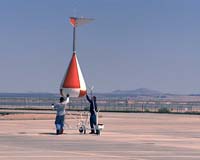 mars-insitu  mars-mers 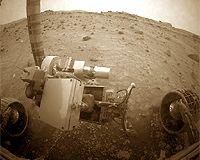 |
 Pasadena CA (JPL) May 08, 2008
Pasadena CA (JPL) May 08, 2008NASA's Phoenix Mars Lander is scheduled to land on the Martian northern plains near 68 degrees north latitude, 127 degrees west longitude on May 25, 2008. In preparation for the landing, NASA's Mars Reconnaissance Orbiter has been monitoring weather in the region around the landing site. On April 20, 2008, the orbiter's Mars Color Imager camera captured this view of a large region of north ... more Opportunity Investigates Arthritic Rover Joint  Pasadena CA (SPX) May 07, 2008
Pasadena CA (SPX) May 07, 2008Opportunity is healthy and all subsystems are performing as expected, with the exception of the Instrument Deployment Device (the robotic arm). Power has improved slightly during the last week, primarily as the result of a better state of charge in the batteries. Given the recent difficulties with the robotic arm, the rover hasn't been using the batteries as much as usual. Energy has ... more Is There Life On Mars - Ask A Magnet  Moffett Field CA (SPX) May 06, 2008
Moffett Field CA (SPX) May 06, 2008Between three and four billion years ago, Mars was a lot like Earth. Both planets are believed to have had surface water. Those similarities make it a prime candidate for extraterrestrial life. "The assumption is that if bacterial life emerged on Earth at that time, then why not on Mars?" says Soon Sam Kim, principal member of technical staff at NASA's Jet Propulsion Laboratory. Mars may a ... more Spirit In A Catch-22: Stay Awake Or Sleep  Pasadena CA (SPX) May 06, 2008
Pasadena CA (SPX) May 06, 2008Spirit's Tau measurements of atmospheric dust have remained steady, but solar array input has dropped a bit to 235 watt-hours per sol. Spirit still has enough energy to squeeze in Moessbauer studies of iron-bearing minerals at a time of year when the rover's handlers expected Spirit to be concerned only with survival. At present, the rover's target of scientific interest is a soil exposure ... more |
mars-atmosphere
 mars-general 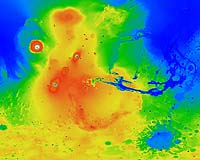 marsexpress 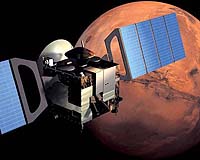 |
 Seattle WA (SPX) Apr 30, 2008
Seattle WA (SPX) Apr 30, 2008Andrews Space has announced that it has signed a contract with the National Aeronautics and Space Administration (NASA) to analyze design solutions related to NASA's Vision for Space Exploration. The specific efforts are focused on the Mars Entry, Descent, and Landing technologies and techniques. Under NASA Langley Research Center's Entry, Descent, and Landing (EDL) research area, Andrews ... more Icy Active Mars  Moffett Field CA (SPX) Apr 28, 2008
Moffett Field CA (SPX) Apr 28, 2008The prevailing thinking is that Mars is a planet whose active climate has been confined to the distant past. About 3.5 billion years ago, the Red Planet had extensive flowing water and then fell quiet - deadly quiet. It didn't seem the climate had changed much since. Now, in a research article that graces the May cover of Geology, scientists at Brown University think Mars' climate has been ... more More Trouble For Opportunity's Robotic Arm  Pasadena CA (SPX) Apr 25, 2008
Pasadena CA (SPX) Apr 25, 2008A small motor in the robotic arm of NASA's Mars Exploration Rover Opportunity that began stalling occasionally more than two years ago has become more troublesome recently. Rover engineers at NASA's Jet Propulsion Laboratory, Pasadena, Calif., are diagnosing why the motor, one of five in the robotic arm, stalled on April 14 after much less motion that day than in the case of several earlier stal ... more Spirit Still Sitting Pretty For This Time Of Year  Pasadena CA (JPL) Apr 23, 2008
Pasadena CA (JPL) Apr 23, 2008Despite a slight increase in atmospheric opacity caused by dust, Spirit is still enjoying higher-than-expected energy levels for this time of year. Solar array input has been approximately 240 watt-hours per Martian day, or sol (100 watt-hours is the amount of energy needed to light a 100-watt bulb for one hour). Clear skies have had the unfavorable effect, however, of causing a drop in ... more
|
mars-mers
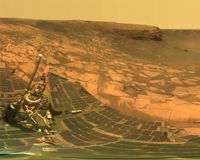 russia-space  eo 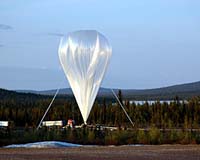 |
| Previous Issues | May 14 | May 13 | May 12 | May 11 | May 09 |
| The contents herein, unless otherwise known to be public domain, are Copyright 1995-2007 - SpaceDaily. AFP and UPI Wire Stories are copyright Agence France-Presse and United Press International. ESA Portal Reports are copyright European Space Agency. All NASA sourced material is public domain. Additional copyrights may apply in whole or part to other bona fide parties. Advertising does not imply endorsement, agreement or approval of any opinions, statements or information provided by SpaceDaily on any web page published or hosted by SpaceDaily. Privacy statement |